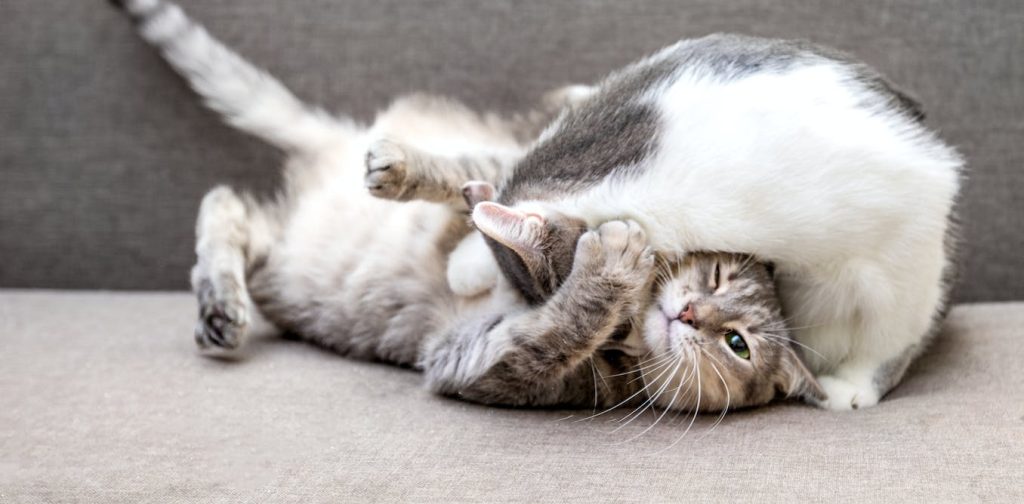Cats and dogs famously don’t get on with each other. We seem quite able to recognise a fight between these two species. However, even experienced cat owners can struggle to tell the difference between rough-and-tumble play and scraps between cats. Some people may tell themselves it doesn’t matter and cats just do what they want. But knowing when to intervene is important for a cat’s welfare.
A recent paper published in Scientific Reports studied how to differentiate between cat-to-cat interactions, including when play escalates to aggression. The study, which analysed videos of cats socialising, found owners can help their pets’ welfare by monitoring their cats and intervening when aggression starts. Another finding was that cats can have short-term disagreements, not unlike the way humans have squabbles with their friends.
But to be a good peacemaker and stop a genuine conflict, you need to understand the evolutionary history of our companion cats’ social lives and interpret their body language.
Cats are originally a solitary species. For the domestic cat, living with us can often mean living close together with other cats. A recent study found that a little over one in two cats (55% of the cats from 5,129 respondents living mainly in the UK, but also other European countries, Australia, Canada, New Zealand and the USA) live in a so-called “multi-cat” household.
Domestic cats are more flexible than their ancestors. They’ve evolved to become a semi-social species. But not all cats can tolerate sharing their home with another cat, which may stress them out.
Heredity factors as well as early life circumstances will affect a cat’s ability to live with another cat. Often same-sex combinations find it easier to share their living space, particularly two females with familial ties.
When cats live together, they may merely share the same home or they may bond. One sign cats enjoy one another’s company is if they sleep together with their bodies and heads directed towards each other.
VasiLyeva.Anna/Shutterstock
But cats may also value a certain spot for warmth, a view, or the company of their human which may make them choose to lie close together. At the same time they may show signs they are too close for comfort, for example they may face away from each other, or one cat may stare the other down. Such cats are also less likely to play together.
Kittens romp with each other and play with objects by themselves. The peak of social play is between the ninth and 14th week of a kitten’s life. Kittens that live with their litter mates for longer may become more practiced at the social skills involved in play. Play is crucial for a kitten’s development. It’s indispensable for cats who will share territory with other cats later in life.
Tom Pingel/Shutterstock
How do you recognise actual, true, play in kittens and cats? Actual play can be recognised by:
1) A balance and equality in the play (reciprocity), for instance switching positions when wrestling and chasing.
2) An inclination for the cats involved to move towards each other (their bodies will be directed towards each other for most of the time) in relaxed and exaggerated ways.
3) They aren’t hissing, growling or spitting at each other.
4) Neither cats’ ears are pinned back.
5) When they raise their paws towards another cat, they keep their claws sheathed.
6) When they bite each other it can be part of the play, but it will be inhibited – so their teeth won’t actually dent the other’s skin (or worse).
Magui RF/Shutterstock
Cats are nuanced, complicated creatures and so is their play. They may also engage in play fighting – a mixture of play and fighting, which may be more difficult to recognise. This kind of interaction can harm the social bond between the cats.
Whenever you hear vocalisations such as growling or hissing, see enlarged pupils, prolonged staring (with hard eyes or tense bodies), the use of claws and teeth (recognisable by hairs coming loose), you need to divert the cats’ attention in a calm way to stop the interaction. For instance by making a soft sound or by offering a toy at a short distance from the cats.
If you find little scabs – wound crusts can be a mere speck – it’s a sign cats were not playing, but fighting.
SunRay BRI Cattery RU/Shutterstock
Social play can be an enrichment for cats, but only if it is balanced and pleasurable for all cats involved. If one cat becomes an object of play, for instance by being chased when it does not want to be chased, don’t laugh it off as “just playing”. Instead, look at alternative ways for all cats to feel safe.
Creating hiding nooks and high places gives somewhere for a cat that does not want to be chased to escape. Cats can play on their own. But even in single-cat households, play is a great way for owners to strengthen their connection with their cat.

